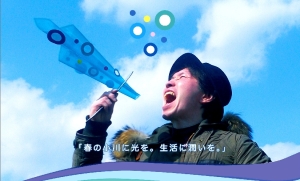Posts Tagged Haru no Ogawa
EVENT: Walking Tour of Shibuya River (Sat Apr 19)
Posted by takw in Event Info on April 17, 2014
 There will be a walking tour of Shibuya River on Saturday April 19. The tour will meet at 13:30 at the No.2 exit of subway station “Shinjuku Gyoen”. The guide will be Kobayashi Masayoshi.
There will be a walking tour of Shibuya River on Saturday April 19. The tour will meet at 13:30 at the No.2 exit of subway station “Shinjuku Gyoen”. The guide will be Kobayashi Masayoshi.
The group plans to walk from Sendagaya to Harajuku, down Omotesando, and Shibuya — I’m guessing right along the Shibuya River. This will be a rare chance to walk down this culverted (covered) river.
It looks like this walking tour is sponsored by Shibuyagawa Renaissance, a group devoted to the deculvertization (the uncovering) of Shibuya River. We had come of know of this group last year (two posts: here and here). On their site is more info about this tour.
Here is the info in Japanese (taken from that site)
4月19日(土)
「春の小川」ウオーキングを開催します。
13時30分・東京メトロ「新宿御苑」駅、2番出口集合。
ナビゲーター 小林政能(日本地図センター)
This might be a nice addition to the Earth Day festivities happening in Yoyogi that day.
And as a bonus, here is an informative article in English about the Shibuya River: Treasure Hunting in the Waters Beneath Shibuya. See also a project called Spatial Dialogues, which has focused on the Shibuya River.
Reviving Rivers through Song (Haru no Ogawa)
Posted by takw in Uncategorized on October 20, 2013
Detruireditellespectrum‘s post about Shibuyagawa Renaissance Project made me look up the song “Haru no Ogawa” (春の小川), a song that all schoolchildren in Japan know. The song, whose title can be translated as “Springtime Stream,” paints a picture of a brook with flowers and fish. In the youtube video above, the song is performed with the pre-war version of the lyrics (the words to the song were changed during the war).
The Shibuya River group has been using this song as their group’s theme music because, according to one theory, the song was written about a river in Yoyogi — and probably the river that is called Shibuya River. This theory is based on the fact that Takano Tatsuyuki, who penned the song in 1912, lived near what is now Minami Shinjuku Station (in Yoyogi) and took walks along Kōbone River (河骨川) — a tributary of Uta River (宇田川), which ultimately flowed into Shibuya River (渋谷川). While there seems to be no documentation that definitely proves this historical link between the song and the river, the Shibuya Ward has claimed this by building a stone plaque commemorating the area as the birthplace of this song. Read the rest of this entry »
Shibuyagawa Renaissance Project (NPO)
Posted by detruireditellespectrum in Event Info, Organizations on October 14, 2013
Their Homepage here!: http://www.shibuyagawa.net/index.html
Hello, everyone! This is Hiromi (RA). I will be posting some information on the organizations that are relevant to the class and might be interesting to check out.
The first one is called “Shibuyagawa Renaissance Project”.
This non-profit organization was founded in 2002 in Yoyogi.
A Note on The Shibuya River
Kimiko Kajiyama, the author of “Aruku Shibuya-gawa Nyumon” writes;
The Shibuya River now flows through Shibuya-ku and Minato-ku to Tokyo Bay. The upper parts were covered and gone under the ground.
Now it’s difficult to see the Shibuya River because the upper part of the river was covered as Tokyo prepared for the Olympics in 1964. They covered the river with new streets and highways. […] Before 1964 it was a dear old river.
Shibuyagawa Renaissance Project
The organization states its restoration purpose as follows:
渋谷川ルネッサンスは、渋谷川を太陽の下を流れる川として再生・復活させる事業及びそれに関連する事業を行い、広く世界の人々に対して水と川の重要性の認識を高め、今後の川に関する諸活動を推進することを目的とするNPO法人です。
They will be having events from time to time. For example, there seems to be a parade on December 15th (11AM), with the starting point at the NHK building.
(Check out here.)
Hope the information is going to be useful for some of you!
Thank you and have a nice day.

Recent Comments